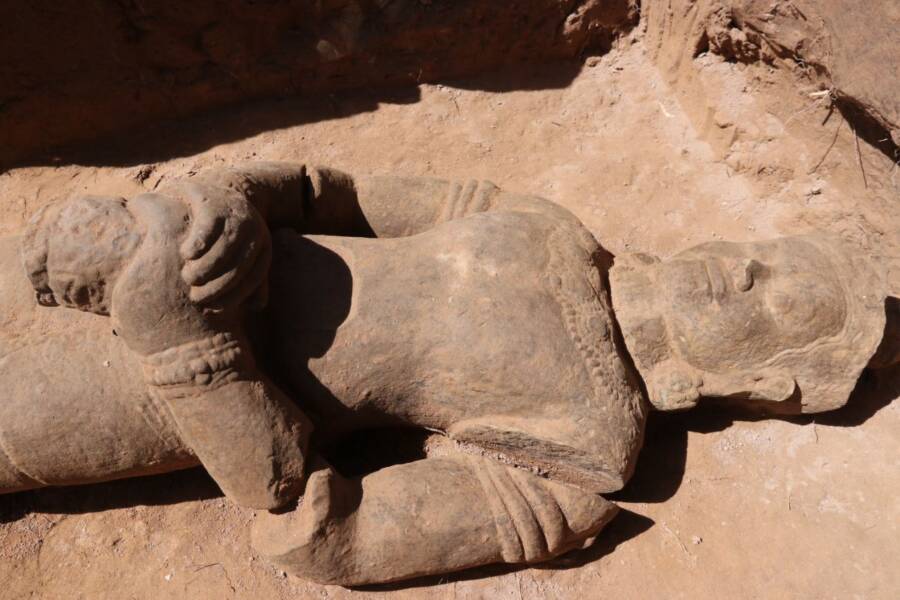In Cambodia’s Angkor Wat Archaeological Park, a jaw-dropping find has once again spotlighted the site’s unmatched historical significance. Amid clearing rubble from a collapsed gate at the Banteay Prei Temple, archaeologists uncovered a stunning life-sized statue. The statue, a “dvarapala,” served as a guardian at the entrance, marking another milestone in our understanding of ancient cultures.
This discovery isn’t just about a statue, though—it’s a portal into a world from 700 years ago. Let’s dive into this remarkable find and its significance in the vast tapestry of Angkor Wat’s rich history.
The Guardian Revealed
The unearthing of the dvarapala—a guardian figure typically depicted as a warrior—came as a pleasant surprise during routine excavation work. Buried beneath the dirt and rubble, the statue was found near the eastern gate of the Banteay Prei Temple, about 31 inches (80 cm) underground. This discovery occurred in the heart of Angkor Wat’s sprawling 250-square-mile park, a site already renowned for its deep ties to both Hindu and Buddhist traditions.
Despite having endured centuries beneath a collapsed gate, the sandstone statue remained mostly intact. There’s something poetic about that—a guardian surviving the weight of a fallen structure, much like the resilient legacy of Angkor Wat itself.

A Warrior’s Past: The Story Behind the Statue
Crafted in the Bayon style, the statue stands over five feet tall. Its serene, smiling face and robust build are classic Bayon-era artistry, a style associated with the reign of King Jayavarman VII. If that name doesn’t ring a bell, he’s the same king who commissioned Banteay Prei in the late 1200s or early 1300s to honor his father. Talk about an impressive Father’s Day gift.
Like many dvarapala statues found across Hindu, Buddhist, and Jaina cultures, this one held a weapon—likely a club or mace—that symbolized its role as a protector. Its body, although fragmented into six parts with damage to its neck, left forearm, and legs, speaks volumes of its role in safeguarding the temple for centuries. And let’s not forget its head, which was found awkwardly lying face down, staring west.
Oh, and a large chunk of its club? Gone. Lost to history, or maybe just to time itself.
Why This Discovery Matters
We’ve all seen our fair share of archaeological discoveries making headlines, but the Banteay Prei dvarapala is something truly special. First of all, Angkor Wat is no ordinary place—it’s Asia’s most photogenic UNESCO World Heritage site (beating out heavyweights like the Taj Mahal and the Great Wall). And in just the first eight months of 2024, over 650,000 tourists flocked to the park, generating a cool $30 million in ticket sales. Let’s face it, Angkor Wat is having a moment—and this statue only adds to the hype.
But beyond its tourism appeal, the find gives us an intimate glimpse into the past. The dvarapala stands as a testament to the enduring power of spiritual symbolism, royal dedication, and the rich tapestry of Southeast Asian art and culture. Its discovery is part of an ongoing narrative—one where every unearthed artifact adds a new page to the story of Angkor Wat.
In fact, earlier this year, more than 100 Buddhist statues were uncovered at Ta Prohm, another temple within the Angkor Wat complex. These statues, also from the Bayon period, showcased Buddha in various serene postures. Combined with the discovery of the Banteay Prei statue, it’s clear that Angkor Wat continues to surprise archaeologists and historians alike with new insights into the past.
Preserving History for the Future
Once the dust settled—literally—the statue was carefully transported to the Preah Norodom Sihanouk-Angkor Museum. There, it will undergo further study and preservation. Archaeologists, no doubt, are eager to learn more about its role in temple life, its exact origins, and the mysterious circumstances that led to its burial beneath a collapsed gate.
And while the temple may be remote, its story is now on the world stage. As archaeologists continue to sift through centuries of history, there’s no doubt that even more treasures lie beneath the surface, waiting to be uncovered.

What’s Next for Angkor Wat?
Angkor Wat is not just a tourist destination—it’s a treasure trove of history. With more than 250 square miles of temples, gates, and ruins to explore, archaeologists are just scratching the surface of what lies beneath. The discovery of the Banteay Prei dvarapala hints that there are likely many more hidden gems still buried under centuries of soil, waiting to tell their story.
This year alone, the park has seen monumental discoveries, including the Buddhist statues at Ta Prohm and now this incredible gate guardian. Each new find offers fresh insights into the Bayon period’s intricate artistry and the cultural significance of these sculptures.
It’s only a matter of time before the next discovery grabs headlines.
Call to Action: Engage with the Past
Curious about the ancient wonders of Angkor Wat? Ready to dive deeper into its captivating history? Don’t just be a spectator—become part of the conversation. Share your thoughts, book a visit, or join an archaeological expedition. After all, you never know what hidden treasures you might help uncover next.
And, of course, stay tuned for more updates on the ever-evolving story of Angkor Wat—where ancient history meets modern-day discovery.

